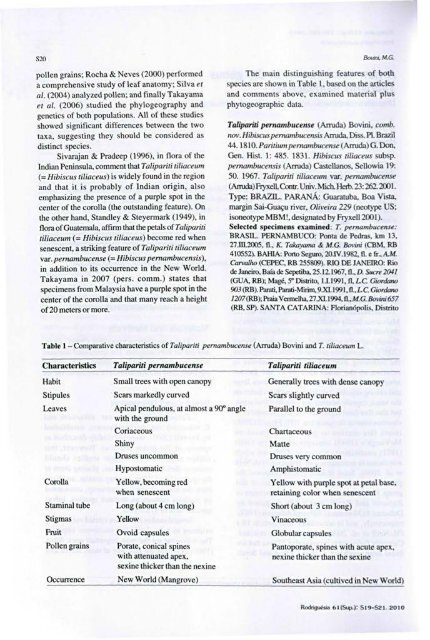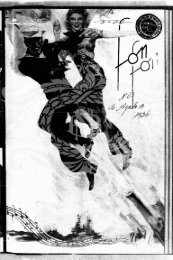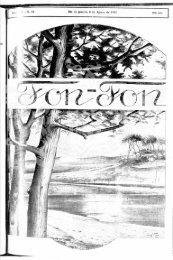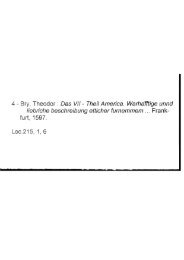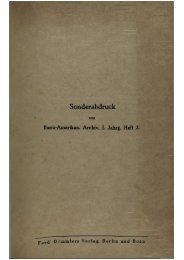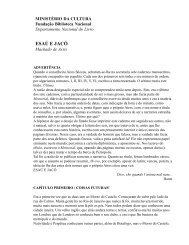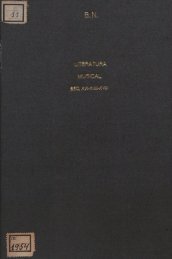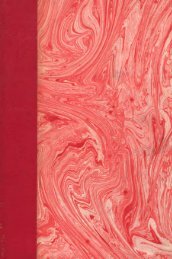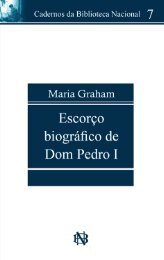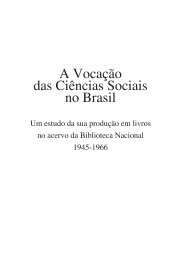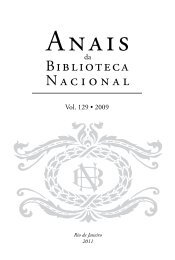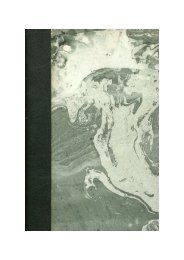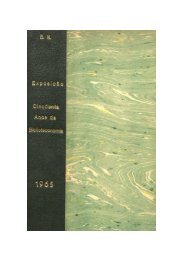vol. 61, Supl. - Fundação Biblioteca Nacional
vol. 61, Supl. - Fundação Biblioteca Nacional
vol. 61, Supl. - Fundação Biblioteca Nacional
Create successful ePaper yourself
Turn your PDF publications into a flip-book with our unique Google optimized e-Paper software.
S20<br />
pollen grains; Rocha & Neves (2000) performed<br />
a comprehensive study of leaf anatomy; Silva ei<br />
ai. (2004) analyzed pollen; and finally Takayama<br />
et ai. (2006) studied the phylogeography and<br />
genetics of both populations. Ali of these studies<br />
showed significam differences between the two<br />
taxa, suggesting they should be considered as<br />
distinct species.<br />
Sivarajan & Pradeep (1996), in flora of the<br />
Indian Península, comment that Talipariti tiliaceum<br />
(= Hibiscus tiliaceus) is widely found in the region<br />
and that it is probably of Indian origin, also<br />
emphasizing the presence of a purple spot in the<br />
center of the corolla (the outstanding feature). On<br />
the other hand, Standley & Steyermark (1949), in<br />
flora of Guatemala, affirm that the petals of Talipariti<br />
tiliaceum (= Hibiscus tiliaceus) become red when<br />
senescent, a striking feature of Talipariti tiliaceum<br />
var. pemambucense (= Hibiscus pernambucensis),<br />
in addition to its occurrence in the New World.<br />
Takayama in 2007 (pers. comm.) states that<br />
specimens from Malaysia have a purple spot in the<br />
center of the corolla and that many reach a height<br />
of 20 meters or more.<br />
Bovini, M.G.<br />
The main distinguishing features of both<br />
species are shown in Table 1, based on the articles<br />
and comments above, examined material plus<br />
phytogeographic data.<br />
Talipariti pemambucense (Arruda) Bovini, comb.<br />
nov. Hibiscus pernambucensis Arruda, Diss. PI. Brazil<br />
44.1810. Paritíum pemambucense (Arruda) G. Don,<br />
Gen. Hist. 1: 485. 1831. Hibiscus tiliaceus subsp.<br />
pernambucensis (Arruda) Castellanos, Sellowia 19:<br />
50. 1967. Talipariti tiliaceum var. pemambucense<br />
(Arruda) Fryxell. Contr. Univ. Mich. Herb. 23:262.2001.<br />
Type: BRAZIL. PARANÁ: Guaratuba, Boa Vista,<br />
margin Sai-Guaçu river, Oliveira 229 (neotype US;<br />
isoneotype MBM!, designated by Fryxell 2001).<br />
Selected specimens examined: T. pemambucense:<br />
BRASIL. PERNAMBUCO: Ponta de Pedras, km 13,<br />
27.UI.2005, fl., K. Takayama & MG. Bovini (CBM, RB<br />
410552). BAHIA: Porto Seguro, 20.IV.1982, fl. e fr., AM.<br />
Carvalho (CEPEC, RB 255809). RIO DE JANEIRO: Rio<br />
de Janeiro, Baía de Sepetiba, 25.12.1967, fl., D. Sucre 2041<br />
(GUA, RB); Magé, 5 o Distrito, 1.1.1991, fl, LC. Giordano<br />
903 (RB). Parati, Parati-Mirim, 9.XI. 1991, fl., L C. Giordano<br />
1207(RB); Praia Vermelha, 27.XI. 1994, fl., M.G. Bovini 657<br />
(RB, SP). SANTA CATARINA: Florianópolis, Distrito<br />
Table 1 - Comparative characteristics of Talipariti pemambucense (Arruda) Bovini and T. tiliaceum L.<br />
Characteristics<br />
Habit<br />
Stipules<br />
Leaves<br />
Corolla<br />
Staminal tube<br />
Stigmas<br />
Fruit<br />
Pollen grains<br />
Occurrence<br />
Talipariti pemambucense<br />
Small trees with open canopy<br />
Sears markedly curved<br />
Apical pendulous, at almost a 90° angle<br />
with the ground<br />
Coriaceous<br />
Shiny<br />
Druses uncommon<br />
Hypostomatic<br />
Yellow, becoming red<br />
when senescent<br />
Long (about 4 cm long)<br />
Yellow<br />
Ovoid capsules<br />
Porate, conical spines<br />
with attenuated apex,<br />
sexine thicker than the nexine<br />
New World (Mangrove)<br />
Talipariti tiliaceum<br />
Generally trees with dense canopy<br />
Sears slightly curved<br />
Parallel to the ground<br />
Chartaceous<br />
Matte<br />
Druses very common<br />
Amphistomatic<br />
Yellow with purple spot at petal base,<br />
retaining color when senescent<br />
Short (about 3 cm long)<br />
Vinaceous<br />
Globular capsules<br />
Pantoporate, spines with acute apex,<br />
nexine thicker than the sexine<br />
Southeast Ásia (cultived in New World)<br />
Rodrigues» <strong>61</strong>(Sup.): S19-S21. 2010


